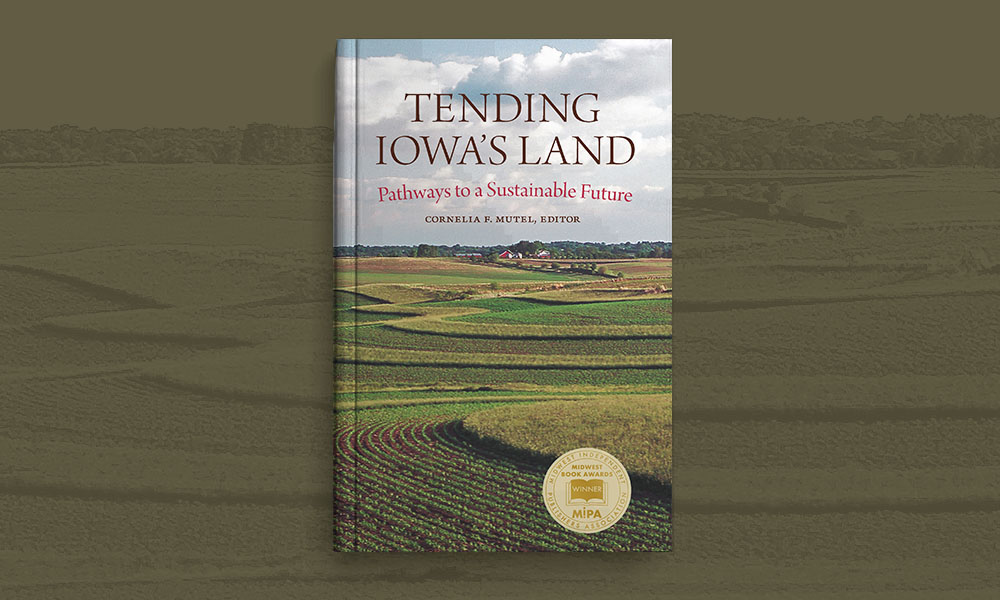Iowa Environmental Expert Searches for a Path to Sustainability
 Tending Iowa’s Land: Pathways to a Sustainable Future, edited by Cornelia F. Mutel, University of Iowa Press, 302 pp.
Tending Iowa’s Land: Pathways to a Sustainable Future, edited by Cornelia F. Mutel, University of Iowa Press, 302 pp.
 Environmental science writer Cornelia Mutel
Environmental science writer Cornelia Mutel
I
n the past 200 years, Iowa’s prairie has been transformed into croplands and confined animal feeding operations that provide fuel and food, but also present environmental challenges for the state. Cornelia Mutel, a retired senior science writer for University of Iowa IIHR-Hydroscience & Engineering, recently spoke with Iowa Magazine about these issues discussed in her award-winning book Tending Iowa’s Land: Pathways to a Sustainable Future. The anthology features essays from scientists, scholars, and farmers who are committed to improving agricultural practices to restore the Iowa biome, which Mutel describes as among the most altered terrain on Earth.
How are Iowa’s environmental challenges with soil, water, air, and biodiversity related?
All environmental features are interconnected. They work together either positively or negatively. In Iowa’s native prairies, the soil and water fed diverse life, which sequestered carbon and helped moderate the climate. When the prairies were plowed, these healthy interactions were disarticulated: water started eroding exposed soil, which polluted water and released greenhouse gases that affected climate. Biodiversity dropped. Reintroducing nature back into agricultural lands through regenerative agriculture can help reestablish nature’s former healthy landscape processes.
Farms used to be self-contained. The animals that pulled the machinery grazed on pastures fertilized by the animals that lived there. Is it possible to return to farms being self-sustaining?
Even in the “good old days,” some problems were worse than they are now. Rivers were murky with sediment and manure. In addition to old problems, we have new ones to deal with. When Iowa was first settled, agriculture could count on gentle rains throughout the growing season. Now weather is less predictable. Rain often comes in huge storms, and climate change drives the extremes: periods of heavy rain and drought. Because of heavy rains, croplands are being tiled more, which shoots more pollutants directly into drainageways. Meanwhile erosion continues. Iowa used to have 16 inches of topsoil on average. Now we have 6-8 inches. Some say we are “mining” our topsoil, and that in 50 years, it will be gone.
Instead of looking backward, let’s look forward. Today’s regenerative agriculture involves planting cover crops to improve soil year-round, using buffer strips along the streams and drainages to decrease runoff, and planting prairie strips in cropland that produce pollinators and catch eroding soils. These practices will help control modern problems, but we will always need to remain vigilant and adapt to evolving conditions.
In your book, a farmer writes that in the past, the cows moved out to pastures to graze, but now “the cows stay in one place, and…the grass moves to the cows.” What problems does that create?
It creates problems with manure, which is now concentrated in confined animal feed operations instead of being dropped on pastures where it feeds the soil. Today’s concentrated manure is supposed to be treated on-site, but too often it escapes into streams and ultimately runs into the Gulf of Mexico, where it creates an immense dead zone.
Manure problems are accentuated by tremendous increases in Iowa’s confined livestock. In 1980, 65,000 Iowa farmers raised 13 million hogs, about 200 to a farm. By 2002, 10,000 farmers raised 14 million hogs. In the last 40 years, hog numbers rose from 200 to 4,700 per operation. In 1997, Iowa had 21.5 million egg-laying chickens. By 2017, we had 56 million, nearly all raised in operations of 100,000 or more birds.
There’s no way Iowa can handle concentrated waste from this many animals. It’s expensive to transport, so it’s spread within a few miles of a confined animal feed operation. Elsewhere, Iowa farmers fertilize with nitrogen—5 million metric tons were applied in 2022.
Many of the things we’re doing with modern agriculture disarticulate natural processes, rather than nurturing life. Nature tells us that healthy interconnections among plants, animals, and natural processes are critical life-supports. We have techniques to deal with today’s environmental problems. It’s just a matter of doing these things, fast.
Your book sounds a warning, but it also provides solutions, such as those you’ve shared in this interview.
There is indeed hope. Millions of people around the world are passionately working on these environmental problems, as are many in Iowa.
